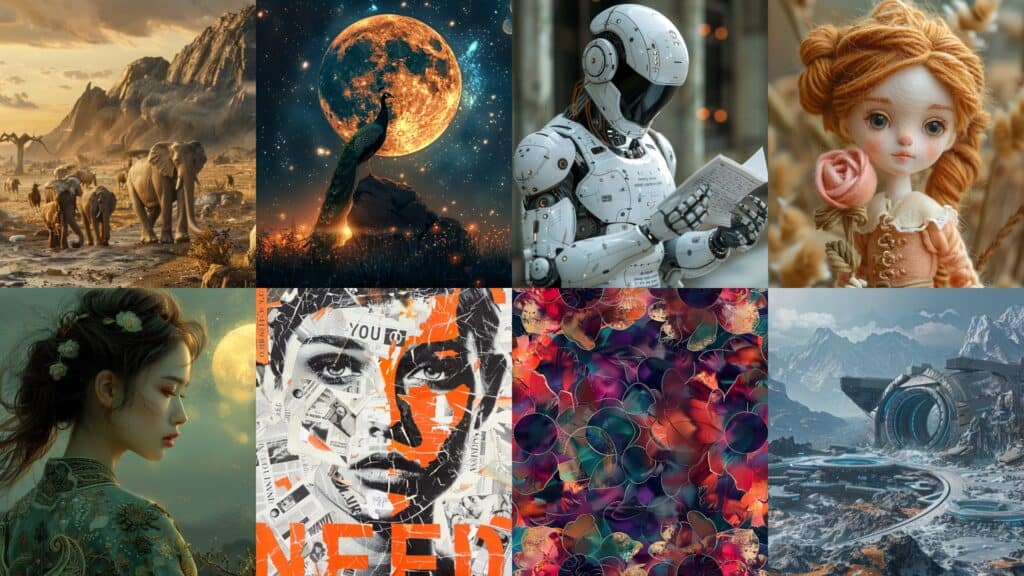Midjourney tips and tricks for beginners – additive prompting explained

Table of Contents
Midjourney is an amazing AI art generator capable of producing stunning visual images. However, it requires a little knowledge to get the most out of it. In this article, we’ll help you level up by introducing you to additive prompting. Then, we’ll link you to some of the best Midjourney creators around, to help you 10x your image generation game. Let’s dive into the ever-evolving world of Midjourney.
Midjourney: Getting started
If you’re new to Midjourney, you’re going to need a Discord account, at least for now. Midjourney has confirmed that Discord won’t be needed to get started creating images for much longer, but you’re still going to need one for now. Head here to register, create a free Discord and invite the Midjourney Bot. Once done, you’ll be able to access the Bot across mobile, web, and desktop. If you’re on the fence with Midjourney, you can check out our thoughts in our Midjourney review.
Prime Day may have closed its doors, but that hasn't stopped great deals from landing on the web's biggest online retailer. Here are all the best last chance savings from this year's Prime event.
- Sapphire 11348-03-20G Pulse AMD Radeon™ RX 9070 XT Was $779 Now $719
- AMD Ryzen 7 7800X3D 8-Core, 16-Thread Desktop Processor Was $449 Now $341
- Skytech King 95 Gaming PC Desktop, Ryzen 7 9800X3D 4.7 GHz Was $2,899 Now $2,599
- LG 77-Inch Class OLED evo AI 4K C5 Series Smart TV Was $3,696 Now $2,996
- AOC Laptop Computer 16GB RAM 512GB SSD Was $360.99 Now $306.84
- Lexar 2TB NM1090 w/HeatSink SSD PCIe Gen5x4 NVMe M.2 Was $281.97 Now $214.98
- Apple Watch Series 10 GPS + Cellular 42mm case Smartwatch Was $499.99 Now $379.99
- AMD Ryzen 9 5950X 16-core, 32-thread unlocked desktop processor Was $3199.99 Now $279.99
- Garmin vívoactive 5, Health and Fitness GPS Smartwatch Was $299.99 Now $190
*Prices and savings subject to change. Click through to get the current prices.
Recognise Midjourney’s limits
Don’t stuff everything in your prompt. Using additive prompting can help make your Midjourney experience far more effective. Remember, respect the fact Midjourney will understand a lot, but not everything.
The Prompt
The prompt is foundational in generative AI tools and it’s no different in Midjourney. While the recent introduction of Image References, Style References, and Character References has increased the importance of using images directly inside Midjourney, the prompt is still a cornerstone piece for controlling your generation.
You can prompt in Midjourney in many ways, but a great place to start is with the Additive Prompting Framework developed by MidJourney pioneer Nick St. Pierre. It’s an exceptional approach, one that builds from simple ideas to complex images, and provides a lot of power to control your Midjourney generations.
To create your first image using a prompt, you’re going to need to use Discord commands. To do this, follow these steps:
- Hit Enter “/” and then “Imagine”
- Type in the prompt you want Midjourney to create
- For example: /imagine prompt: A dog playing a violin while surfing on a wave and eating a slow-roasted leg of lamb
1. Start Simple
If you’re using Discord, use the prompt box with the /imagine command, If you’re using the Midjourney web alpha, type your prompt into the main prompt text box—you don’t need to type anything else.
Midjourney will respond to anything you type. So, your basic idea can be as simple as an emoji 🤖, a single word, or a two or three-word idea. Midjourney is exceptionally good at producing pleasing images, and the most basic input will provide you with an image to build on.
To get started here, I’ve typed a few simple words to create three basic images:
- Waterfall
- Retro Space Ship
- 🤖 Yes, you can use emojis! They don’t always return what you expect, but they’re fun to play with! In this case, Midjourney recognized that I wanted it to create a robot!
You don’t have to be quite this sparse. I’m simply demonstrating that you don’t need to worry about how to begin. The additive approach relies on getting your main idea out first. So, you might start with something like:
- Street-style photo of a man outside a cafe
- Digital art of a futuristic cityscape at night
- Charcoal drawing of a mysterious figure in a foggy, cobblestone alley.
Whatever you type is up to you. The simpler you start, the easier it is to experiment later. Just capture your basic idea.
Midjourney will return a variety of concepts and styles: photographic, illustrated, painterly, etc. If you know from the start that you’re going for a cinematic look, you can prompt for “Film Still 35mm” or whatever look you want. If you don’t know what you have in mind, or you’re looking for some inspiration visit MidLibrary which has an incredible resource of tested styles and artists for you to explore.
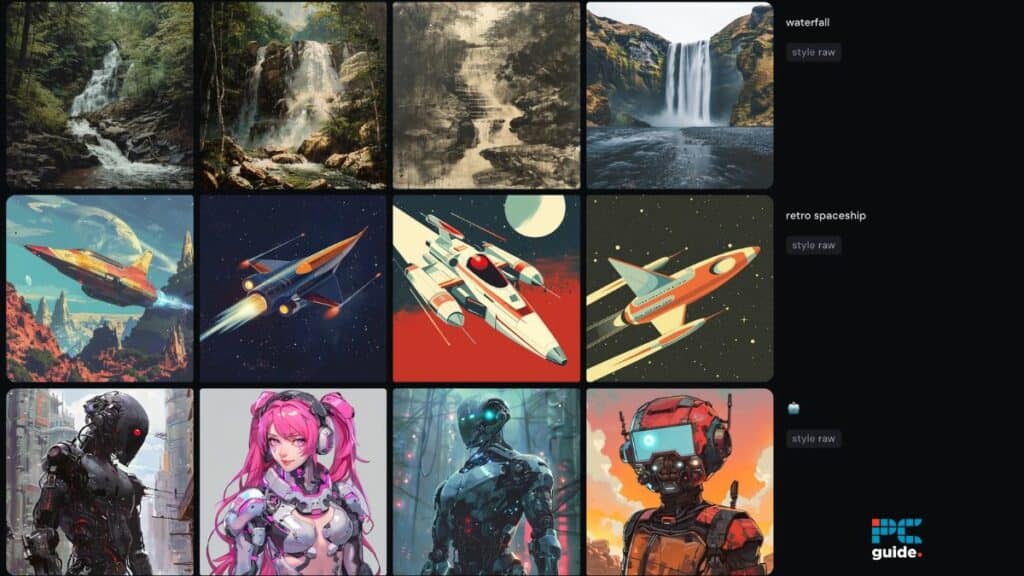
2. Add Details & Describe the Setting
Once you have your basic image and idea, add some additional details. Details and settings can dramatically change your image. I’ve added a painting style and an artist’s name to the waterfall image, prompted for a 1950s comic book art look and a ‘space background for the retro spaceship, and I’ve placed the robot in a futuristic metropolis with a neon color palette.
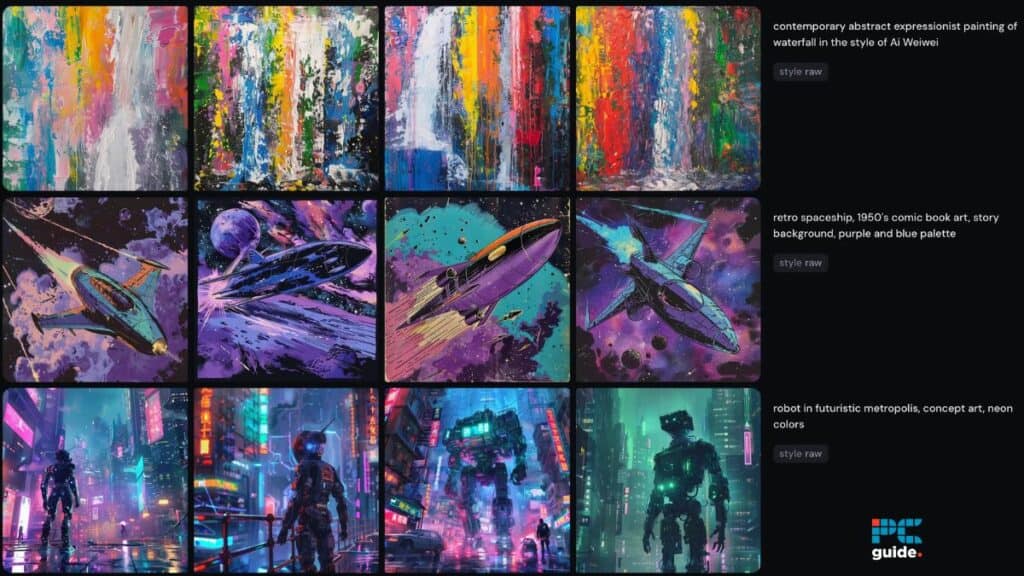
3. Final Touches
There’s no specific end point when you’re experimenting with a prompt. There are many ways to manipulate images, so it’s up to you to decide when you’ve done enough; it’s personal taste. Here, I’ve decided to change the color palette to something more suited to a waterfall, turn the retro spaceship into a 1950s comic book cover, and add atmosphere, detail, and an aesthetic to the robot image.
Of course, you can return to any image in your gallery and rework it at any time, deciding to blend it with another image, re-prompt the details, change a set of parameters, or simply use the mood or character in another image. These images aren’t ‘finished’. They’re simply finished for now. Midjourney is an endless rabbit hole you can explore to your heart’s content.
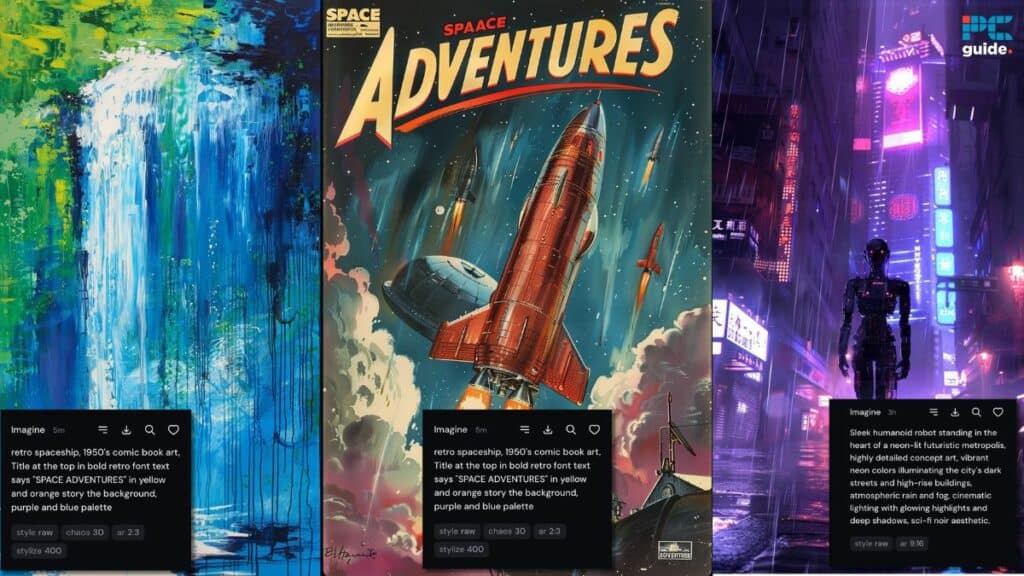
The Full Prompt
Additive prompting is a framework for building your prompt that relies on a set of parameters that can be re-rolled to suit your needs. As laid out by Nick Saint Pierre, the framework works as follows:
- Set the main scene
- Describe the details
- Describe the setting
- Explore style and mediums
Prompt Details
Experienced Midjourney users have found that it can effectively handle between 5 and 7 complex ideas within a single prompt. However, when the prompt becomes too complex, the AI may start to omit certain elements from the generated image. To ensure the best results, it’s recommended to keep prompts concise and focused. You can always build on your ideas by re-prompting.
In the image below, I’ve tried to push quite hard on the number of details Midjourney will handle in the prompt. The prompt is the same for each image. The only thing that’s changed between each set of generations is the application of the Midjourneys ‘Stylize’ and Chaos parameters.
Stylize is a parameter in Midjourey that runs from 0 to 1000. It influences how much or how little of Midjourney’s training is applied to the image. At low settings, Midjourney will follow the prompt exactly, but as the level rises, it pays slightly less attention to the prompt and more to its training.
Chaos: Adds an amount of variation to the image to prevent Midjourney from producing images that look too similar each time.
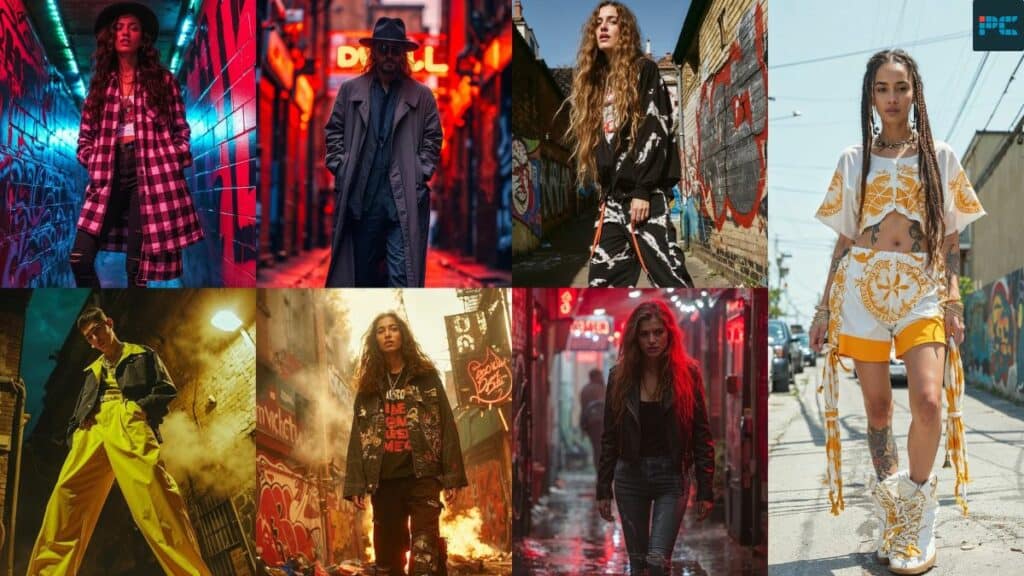
The Prompt:
Streetwear fashion editorial, full-length shot on Hasselblad 500C/M, vibrant neon color grading, a confident young model in oversized avant-garde clothing walking through a gritty urban alleyway, graffiti-covered brick walls, strong contrasting shadows, cinematic lighting, edgy and bold –style raw –chaos 30 –ar 9:16
Breaking Down the Key Components in the Prompt
- Streetwear fashion editorial: A style direction. Midjourney understands what a fashion editorial is, and I’ve indicated, that the focus is on modern, urban fashion.
- Full-length shot on Hasselblad 500C/M: This is a detail about the camera, composition, and framing of the image. It’s telling Midjourney to showcase as much of the model as the aspect ratio allows, show more of the outfit, and use a camera commonly used in fashion photography.
- Vibrant neon color grading: This falls under the direction of styles and mediums, adding a specific color treatment to give the image a contemporary edge.
- A confident young model in oversized avant-garde clothing: The main subject, styling, focal point, and fashion-forward elements for Midjourney to incorporate.
- Walking through a gritty urban alleyway, graffiti-covered brick walls: The main setting and background of the image, directing an overall urban, edgy aesthetic.
- Strong contrasting shadows, cinematic lighting: Lighting and atmosphere are style directions.
- Edgy and bold: An emotional and thematic style description designed as a general direction to Midjouney to guide the emotional tone and depth.
This is by no means a perfect prompt and your elements don’t have to match the additive framework exactly. It’s simply a guide that helps you think about the kind of elements Midjourney is paying attention to. It’s a useful way of prompting, and it can be applied to almost any image.
What’s Next?
Now that you have a solid framework for how to prompt you’re well on your way to creating great images. Of course, there’s a great deal more you can do with Midjourney but it all comes back to mighty prompt.
Check out a few resources and people listed below. They can be of enormous help as you start to level up with Midjourney.
- Nick Saint Pierre – Nick is a Midjourney master, His X account is a treasure trove of Midjourney ideas.
- MidLibrary.io – Andrei Kovalev has created an astoundingly deep resource of genres, artists, and styles for Midjourney
- Marco – The creator of the Midjourney Prmpt Magazine.
- TokenizedAI – Run by Christian Heindhoren this Midjourney YouTube channel goes deep.
- FutureTechPilot – Weekly updates from the official Midjourney Office Hours on Discord and useful Midjourney deep dives.
- Thaeyne– Midjourney prompt explorer extraordinaire Thaeyne pushes the edges of what Midjourney can do.
- Scoblizer’s Best AI Artists list has over 2k members. A great place to find out everything about generative art.
- Jennifer Mishra has a great channel full of beginner-friendly tips, style exploration, & a supportive community.
- Don’t Forget the granddaddy of them all, the super useful Midjourney manual!
That’s it for now. Use the additive prompting framework in your Midjourney workflow, start creating beautiful Midjourney images, and have fun! 🤩
